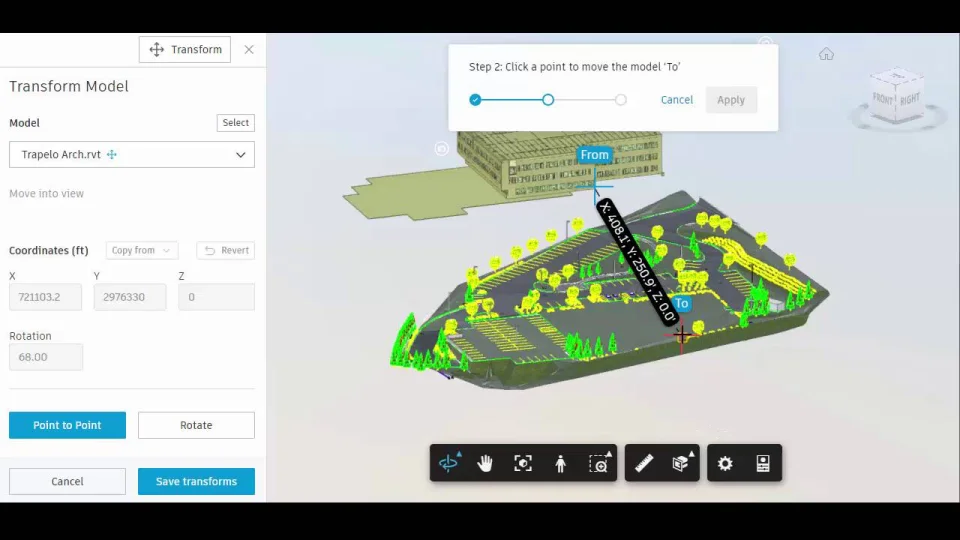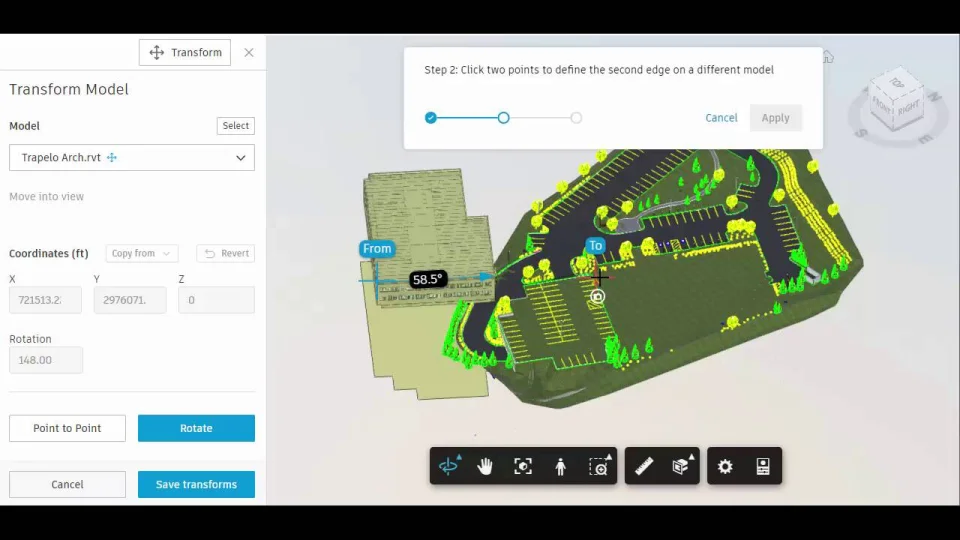Transform Models
Viewing multiple models using the Project Model in Design Collaboration allows you to understand how different disciplines and trades, often represented as separate models, fit together. This allows for collaborative development of the designs. Precise model positioning is therefore important to help ensure design changes are accurate and valid.
The Transform feature allows you to check the alignment of models within the project, and edit their position and rotation. When you have transformed your models, the new positions are used anytime those models are viewed in context of the project.
See the Transform FAQ topic for more information on the specific use cases of the Transform feature in Design Collaboration.
Permissions for the Transform feature
To use the Transform feature in Design Collaboration, you need Edit or Manage permissions for the team folder the work-in-progress (WIP) models are in. If you don’t have these permissions, the feature isn't visible.
Access the Transform feature
To open the Transform feature:
- Check you have the required team selected in the Timeline.
- Open the project model.
- In the left panel, click Teams
 .
. - Click Transform
 at the top of the panel.
at the top of the panel.
Use the Transform options
Select the model you want to transform. You can either click a model in the viewer or select a model from the drop-down list in the Transform Model panel.
Tip: You can click the Select button to deselect the current model and pick another one.Note: Models with a lock icon next to their name in the drop-down list can be selected but not transformed. They may be owned by another team, or may have been shared.
next to their name in the drop-down list can be selected but not transformed. They may be owned by another team, or may have been shared.If the selected model is positioned far from the other models, use the Move into view option to move the selected model into the center of your current camera view.
The Coordinates fields show the current coordinates of the selected model, which are based on the coordinates in the file from the authoring software. Edit the coordinates by typing in the fields, or hover over the fields and use the arrows to increase or decrease the coordinates in units of 1.
Use the Copy from drop-down list to copy coordinates from one of the other open models to the selected model.
Tip: You can also use the handles displayed on the selected model to freely move it around the screen using your mouse.The Rotation field shows the current rotational position of the selected model based on the coordinates in the file from the authoring software, relative to North. Edit the rotation by typing in the fields, or hover over the fields to use the arrows to increase or decrease the rotation in units of 1.
Click Point to Point to move the selected model by picking specific points:
First, click a point on your selected model. This point is used as the reference point to move the model from.
Next, click a point on another model. This point is used as the position that you want to move your selected model to.
Click Apply to align the two points by moving your selected model.
Click Rotate to rotate the selected model by aligning two edges:
First, click two points on your selected model to define an edge.
Tip: The order that you click the two points defines the direction of rotation. After you select the first point, move your cursor to display an arrow. The arrow indicates the direction of rotation based on the position you select for the second point.Next, click two points on another model to define the second edge.
Tip: The order that you click the two points defines the direction of rotation. After you select the first point, move your cursor to display an arrow. The arrow indicates the direction and angle of rotation based on the position you select for the second point.Click Apply to rotate your selected model so that the two edges align.
Use the Revert option to return the selected model back to its original position.
Tip: The Revert option undoes saved transforms. It also works between sessions, for example if you sign out and then continue work on the models later.Click Save transforms to save your changes.
Click Cancel to cancel the transform process. This resets all transform data you have edited and returns the model to its original position.
Transformed models have a transform icon ![]() displayed next to their name. Transformed positions are respected whenever the models are reopened in the project, including in other tools or products in the Autodesk Construction Cloud platform.
displayed next to their name. Transformed positions are respected whenever the models are reopened in the project, including in other tools or products in the Autodesk Construction Cloud platform.


